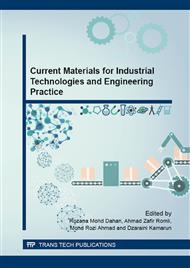[1]
M. Zimniewska, M. Wladyka-Przybylak, and J. Mankowski, Cellulosic bast fibres, their structure and properties suitable for composite applications, in Cellulose Fibres: Bio-and Nano-Polymer Composites (2011) 97-119.
DOI: 10.1007/978-3-642-17370-7_4
Google Scholar
[2]
R. Mahjoub. R. Yatim, J. M. Sam, A. R. M. Hashemi, S. Hamid, Tensile properties of kenaf fibre due to various conditions of chemical fibre surface modifications. Construction and Building Materials, 55 (2014) 103-113.
DOI: 10.1016/j.conbuildmat.2014.01.036
Google Scholar
[3]
J. Summerscales, J. Dissanayake, N. P. J. Virk, A. S. Hall, Wayne, A review of bast fibres and their composites. Part 1 – Fibres as reinforcements. Composites Part A: Applied Science and Manufacturing, 41(10) (2010) 1329-1335.
DOI: 10.1016/j.compositesa.2010.06.001
Google Scholar
[4]
Amel, B. A. Paridah, M Tahir Sudin, R. Anwar, UMK Hussein, S. Ahmed, Effect of fibre extraction methods on some properties of kenaf bast fibre. Industrial Crops and Products, 46 (2013) 117-123.
DOI: 10.1016/j.indcrop.2012.12.015
Google Scholar
[5]
A. Elsaid, A. Dawood, M. Seracino, R. Bobko, C. Mechanical properties of kenaf fibre reinforced concrete. Construction and Building Materials, 25(4) (2011) 1991-(2001).
DOI: 10.1016/j.conbuildmat.2010.11.052
Google Scholar
[6]
N.G. Danalatos, and S.V. Archontoulis, Growth and biomass productivity of kenaf (Hibiscus cannabinus, L. ) under different agricultural inputs and management practices in central Greece. Industrial Crops and Products, 32(3) (2010) 231-240.
DOI: 10.1016/j.indcrop.2010.04.013
Google Scholar
[7]
J. Shi, S. Q. Barnes, H. M. Horstemeyer, M. Wang, J. Hassan,M. El-Barbary, Kenaf Bast Fibres—Part I: Hermetical Alkali Digestion. International Journal of Polymer Science, (2011) 1-8.
DOI: 10.1155/2011/212047
Google Scholar
[8]
L.S. Yaza, L. S. Foo, J. B. Ghafar, S.A.A. Chan, K. W. Tahir, M.I. Paridah, Maznah , Effect of kenaf seed oil from different ways of extraction towards ovarian cancer cells. Food and Bioproducts Processing, 89(4) (2011) 328-332.
DOI: 10.1016/j.fbp.2010.10.007
Google Scholar
[9]
S. Kyung Hun, S.K. Obendorf, Chemical and Biological Retting of Kenaf Fibres. Textile Research Journal, 76(10) (2006) 751-756.
DOI: 10.1177/0040517506070520
Google Scholar
[10]
J.C. Villar, Revilla, E. Gomez, N. Carbajo, J. M. Simon, Improving the use of kenaf for kraft pulping by using mixtures of bast and core fibres. Industrial Crops and Products, 29(2-3) (2009) 301-307.
DOI: 10.1016/j.indcrop.2008.06.002
Google Scholar
[11]
D.V. Parikh, T.A. Calamari, A.P.S. Sawhney, E.J. Blanchard, F. J. Screen, M. Warnock, D.H. Muller, D.D. Stryjewski, Improved Chemical Retting of Kenaf Fibres. Textile Research Journal, 72(7) (2002) 618-624.
DOI: 10.1177/004051750207200709
Google Scholar
[12]
D.E. Akin, B. Condon, Brian, M. Sohn, J.A. Foulk, R.B. Dodd, L.L. Rigsby, Optimization for enzyme-retting of flax with pectate lyase. Industrial Crops and Products, 25(2) (2007) 136-146.
DOI: 10.1016/j.indcrop.2006.08.003
Google Scholar
[13]
M.J.J.H.A. P Mathew and M.Z.B.H.K. Oksman, Preparation of cellulose nanofibres with hydrophobic surface characteristics. springer, 17 (2010) 299–307.
Google Scholar
[14]
H.P.S. Abdul Khalil, Abdul Yusra, AF Ireana Bhat, AH Jawaid, M , Cell wall ultrastructure, anatomy, lignin distribution, and chemical composition of Malaysian cultivated kenaf fibre. Industrial Crops and Products, 31(1) (2010) 113-121.
DOI: 10.1016/j.indcrop.2009.09.008
Google Scholar
[15]
M. Paiva, M. Ammar, I. Campos, A. Cheikh, R. Cunha, A., Alfa fibres: Mechanical, morphological and interfacial characterization. Composites Science and Technology, 67(6) (2007) 1132-1138.
DOI: 10.1016/j.compscitech.2006.05.019
Google Scholar
[16]
D. K Visi D'Souza, N. Ayre, B. G. Webber Iii, C. L. Allen, M. S., Investigation of the bacterial retting community of kenaf (Hibiscus cannabinus) under different conditions using next-generation semiconductor sequencing. J Ind Microbiol Biotechnol, 40(5) (2013).
DOI: 10.1007/s10295-013-1242-1
Google Scholar
[17]
Y.A. El-Shekeil, Sapuan, S. M. Jawaid, M. Al-Shuja'a, O. M. Influence of fibre content on mechanical, morphological and thermal properties of kenaf fibres reinforced poly(vinyl chloride)/thermoplastic polyurethane poly-blend composites. Materials & Design, 58 (2014).
DOI: 10.1016/j.matdes.2014.01.047
Google Scholar
[18]
W. Jinhua and G.N. Ramaswamy, One-step processing and bleaching of mechanically separated kenaf fibres: effects on physical and chemical properties. Textile Research Journal, 73(4) (2003) 339-344.
DOI: 10.1177/004051750307300411
Google Scholar
[19]
J. Zhang, H. Zhang, and J. Zhang, Evaluation of liquid ammonia treatment on surface characteristics of hemp fibre. Cellulose, 21(1) (2014) 569-579.
DOI: 10.1007/s10570-013-0097-y
Google Scholar


